Archive for the ‘ICT Facilities’ Category
The Star – ICT education still lacking in schools

THANKS for highlighting the use of ICT in two model schools SMK Sri Permata and SMK Dindings (StarEducation, Nov 5). ICT is here to stay.
Yet, the poor reinforcement of ICT learning in many urban schools today is both appalling and disturbing.
It has been seven years since the implementation of the Education Ministry’s Smart School project, with 4,500 schools equipped with computer labs.
Yet many students are not getting the benefit of ICT education in schools. Ironically, many students learn more about the Internet in cybercafés than in their schools.
My son is now in Form Two in an urban school and there is no ICT syllabus in his studies. His school has no computer lab while most of the teachers have school-provided laptops.
Very few of the teachers use computer software for teaching, yet many projects and assignments are given to students that require computer applications. Isn’t it likely that students will have to go to cybercafés to complete their assignments?
Needless to say, exposing students to the Internet reaps a wealth of benefits. Some of the benefits are:
Firstly, the principal must be a far-sighted leader to realise the importance of ICT education.
Secondly, computer labs must be made easily accessible to students who should be given free time to log onto the Internet for purposes other than doing school assignment. To create the ICT culture, students must be encouraged to use the computers.
On the flip side, teachers must also be given computer software and Internet training to keep abreast with ICT knowledge.
Thirdly, the school must have PTA support as well as the benefit of the Education Ministry’s training in handling hardware and software. Only a committed partnership will ensure the success of ICT use in schools.
I fully agree with Chua of SMK Sri Permata that the school computer lab is a safer place than the cybercafé. It is a way to help solve social problems among teenagers.
Fourthly, use students to take charge of computer labs. This will help reduce the teachers’ workload and make the students feel a sense of achievement. This can be done by setting school rules to guide the students on computer use.
School principals should wake up and start to integrate the use of ICT into their school activities for the sake of the students.
Original Story Link – http://thestar.com.my/education/story.asp?file=/2006/11/12/education/15941321
TUAMKC,Selangor
The Star – More schools open up to ICT
 BY HARIATI AZIZAN
BY HARIATI AZIZAN
SEVEN years after the Education Ministry introduced the Smart School computer programme project at 88 schools, a total of 4,495 more are now equipped with computer labs, in line with the ministry’s Making Schools Smart programme.
An evolution of the pilot smart school project, the Making Schools Smart programme is built on the various ICT initiatives from the smart school project to educational television broadcast service (see chart) 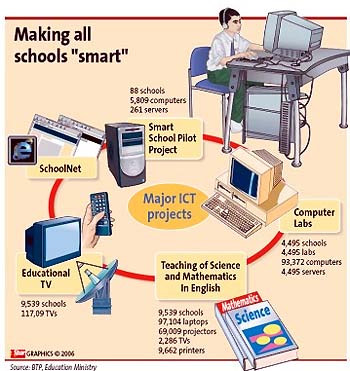
However, according to the ministry’s Educational Technology Division (BTP) director Datuk Yusoff Harun, contrary to common belief, the Malaysian smart school is not one that is solely ICT rich but rather one that optimises ICT and other educational technology to help students learn effectively.
Early this year, 10 pilot schools in the Kalabakan area of Sabah were equipped with Internet-ready “Access Centres.†to give students and teachers more ICT exposure.
The success of this programme has led to the setting up of Access Centres in 74 other primary and secondary schools in the rural areas of Sabah and Johor.
The Access Centres are similar to cybercafes but they focus on learning and enabling students to work on their assignments.
This is different from the existing computer labs, which are used to conduct lessons for certain subjects and will be housed in a separate room.
Recently, Education Minister Datuk Seri Hishammuddin Tun Hussein announced that up to 1,500 schools will be equipped with the Access Centres.
The implementation, which costs more than RM70mil, is the first phase of the project and will see the 1,500 schools receiving 15,000 personal computers, 1,500 printers as well as the necessary furniture.
Next year, another 1,290 schools will receive 10 computers each.
With the Access Centres, the ratio of computers to students would be reduced, allowing students more ICT access.
Access Centres could even be opened to the community as its local ICT centre.It is also hoped that the number of students frequenting cybercafes will be reduced when the Internet service in schools functions properly.
To assist schools manage their ICT facilities, the ministry is drawing up guidelines.
To ensure security, different insurance schemes for the computer labs are being studied.
The ministry has also promised that the schools without basic amenities would have power and water supply by 2010, and would have their generator sets upgraded during the interim period.
Original Story Link –
http://thestar.com.my/education/story.asp?file=/2006/11/5/education/15895598
The Star – Students take charge
The Star – Sunday, 5th November 2006
Original Story Link – http://thestar.com.my/education/story.asp?file=/2006/11/5/education/15903734
THE first thing that you notice when you walk into a computer lab of SMJK Dindings is the lack of grilles, bolts or chains.
The doors are flung wide open and anyone can walk in and out of the computer labs freely.
And most progressive of all is – no teacher supervision.

SMJK Dindings students also helped build the school’s computer labs.
SMJK Dindings students also helped build the school’s computer labs.
“I believe that people basically can be trusted and educated. But I also believe that if the punishment is hard, swift and fast when a rule is broken, people will tow the line,†says SMJK Dindings principal Tiong Ting Ming.
Discipline is the rule at the school and that includes computer usage and Internet etiquette.
He says that he begins with instilling discipline in students.
“They must abide by the school rules – be on good behaviour, dress smartly, and keep the schools clean and orderly. When that is instilled, discipline in other areas comes naturally.â€
Tiong is not one to mince his words and his students know that.
Those who are caught visiting violent or pornographic websites are given public caning at the school’s assembly.
A cyber hub by the sea
Tiong says at the end of the day it is down to the question of need.
“Students know that they will forfeit their right to use the computers if they are caught doing what they are not allowed to in the labs, so they don’t try anything,†he adds.
Pasted on notice boards all around the school and inside the labs, the rules are few and clear, including no sharing of password or user account and no wastage of ICT resources and no computer games.
The open policy at the humble small town school seems to work.
At Dindings, students and teachers have easy access to ICT facilities with its flexible opening hours including on weekends or during holidays.
Along with the unlimited access to the Internet, they are also provided with printing facilities. There is no limit for computer use in the school but students are expected to log off after an hour if the labs are crowded.
SMJK Dindings also has the honour of being the only non-technical secondary school offering the specialised Fundamentals of Programming subject for Sijil Pelajaran Malaysia (SPM).
High-tech road
The school’s high-tech journey began when Tiong became its principal in 1991.
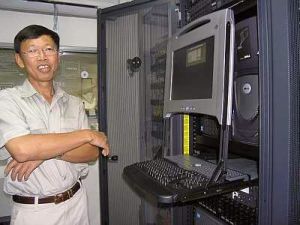
TIONG: I entrust students to manage and maintain the school’s ICT facilities. I don’t rely on the teachers.
The dropout rate was high and to persuade students to stay in school, Tiong introduced ICT courses.
With initiative, enthusiasm and hard work, the semi-government school managed to equip itself with ICT facilities.
Tiong’s friends in technology firms donated second-hand equipment, which he and his students repaired during their spare time.
The beginning, he admitted, was difficult with a lot of teachers and students resisting change.
After raising RM470,000 through various contributions in 1993, the school constructed its new building wired with the latest high-speed Internet connections.
Now, there are about 130 computers – in five computer labs, the library, staff room and even in the classrooms. With the expanded infrastructure, Tiong set up a team of computer prefects or cyber brigade.
They got the support of IT company Microsoft and the Education Ministry, and students are provided training to repair and maintain ICT facilities.
Duties include maintaining and upgrading the ICT facilities as well as repairing the hardware.
Form Four cyber brigadiers Yee Yin San and Ho Zi Ling say the training they received has been very useful.
“Sometimes, when our own computers break down we can repair it ourselves,†says Yee.
Proud of his team of “helpersâ€, Tiong says it all depends on how students are treated.
“I entrust them to manage and maintain the school’s ICT facilities and students take charge. I don’t rely on the teachers. Everything is done by the students.â€
Free access
Still, a filtering software is installed to track students’ Internet outings. The “Squidguard†blocking specific websites deem undesirable.
“You can’t be 100% thorough but if students break the rules too often, we’ll catch them.
“Students can go on the Internet to search for information on what they like such as music and movie, mobile phones and cars.
“They also love to download and share those files; indirectly they are learning to communicate and how to conduct research on the Internet,†he says.
Chatting is allowed but certain networking websites like MySpace and YOUTube are blocked during the exam period.
He adds that although there are educational games, most students play only “shooting†games.
“It is important to create the right ICT culture in the school. If we allow students to play online games, the labs will become game houses and neither we, nor the parents, want that.â€
The printer log files and quota system effectively control printer usage while the centralised virus scanning and spam control filter out the viruses and spam mails.
The wired and wireless CCTV system at strategic locations records the people accessing the ICT facilities and help guard the ICT equipment.
Tiong admits that even with the availability of computers, some students still visit cybercafes.
“I believe a very small percentage of them go to cybercafés to play games or surf pornographic sites and not to do their homework. Most of them will come to school to use the computers and Internet facilities anyway.â€
He feels that stricter regulations on the licensing of cybercafes will not affect his students.
“It is not cheap to use Internet and ICT facilities in cybercafés. In school, the ICT facilities and lessons are readily available, all for only RM12 a month.
“As far as my school is concerned, stricter regulations will actually drive more students back to school.â€
Lauding the government’s move to set up cybercafes in schools, he nonetheless feels that it will depend on how well the schools manage the easy access to ICT facilities.
“The easy access to ICT facilities, the Internet proxy and tracking policy, the monitoring of ICT usage and the safety of ICT equipment will determine the failure or the success of the plan to set up the cybercafés in school.
“For my school, I am confident enough to let the students use the ICT faculties without adult supervision during school hours because the monitoring and tracking system is reliable and the rules and regulations effective,†he adds.
RFID – A Case Study – SMJK Dindings, Lumut, Perak

This Malaysian school is adopting an innovative interdisciplinary approach to learning, and their philosophy to managing their human resources and physical assets. Starting November 2004, they will be using the MiFare RFID tags to take student time and attendance and access control to their server room. They may expand their use to include RFID smart labels to identify and secure assets such as library books, notebooks and other assets. While the use of RFID in schools is not widespread at this time; the integration of the RFID tags with the existing School Management Systems will make this school more efficient in their monitoring functions.
Mr Tiong Ting Ming, a well-known pioneer of ICT deployments in schools, is a strong believer in using technology to aid in normal day-to-day teaching, learning and administration. He understands that the tasks of managing school involves working with information and building on teaching ideas collaboratively. The efficiency and effectiveness of this management task can be enhanced significantly through the use of technology.
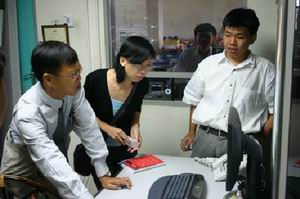
Tiong has been looking at ways to supplement his School Management Systems for attendance tracking for students and staff; he did a pilot implementation last month to record the time of day students arrive in the morning with an initial issuance of 200 RFID cards and with 10 classrooms mounted with the RFID readers that were linked centrally to his School Management Server in the School. The pilot launch was to look at how users react and responded to the new technology before a full scale launch when school resumes in. Eventually he’d like to expand the system to track students’ punctuality (or lack thereof) for every class and to verify the time they get in and out of school, with an option for parents to be notified by SMS.
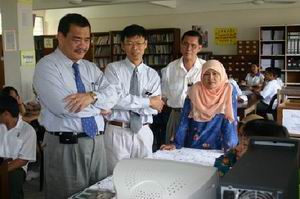
If funding is available, he plans to experiment with the use of the RFID’s 1 K information storage to track library loans, disciplinary records and with visits to the disciplinary office; where transactions will be recorded on the RFID chip.
“That way, we could confirm that a student goes off at 11:15am at the school gate,” Tiong said. “All this relates to attendance and keeping track of kids…. Eventually it will become a monitoring tool for us for all students, including teachers, and we can show parents with the click of a mouse how many times their kids were late or absent from school.”
“Before this, everything was done manually, our teachers would take attendance and send it down to the office, where the admin staffs have to compile and consolidate these attendance records” he said. “Now it’s automatic, and it saves us a lot of time.”
“With the help of Perridot Systems, we will also make full use of this implementation by asking our school security guard to go on a night patrol in the school compound, he will be required to clock in to every assigned school blocks to see that everything is in order at night, or school holidays,†said Tiong. “With this we will be sure he is doing his duty, I can monitor from home to see he is going around the compoundâ€
Radio-frequency identification tags — which have been hailed as the next-generation bar code – consist of a microchip outfitted with a tiny antenna that broadcasts an ID number to a reader unit. The reader searches a database for the number and finds the related file, which contains the tagged item’s description, or in the case of SMJK Dindings, the student’s info.
Unlike bar codes, which must be manually scanned, RFID-tagged items can be read when they are in proximity to a reader unit, essentially scanning themselves. The school uses passive RFID tags that are activated when radio waves from the reader reach the chip’s antenna. (Active RFID tags incorporate a battery that constantly broadcasts the chip’s ID number and are much more expensive.)
The RFID technology adopted by the school is Mifare cards, following the standards set by the government. In the near future, when every student has their new 64K MyKad issued, everyone will carry a ready-made RFID card.
Students in other part of the country can also use their MiFare compliant Touch-N-Go card as Attendance Card as well.
The SMJK school’s 800+ students wear small plastic cards around their necks that have their photograph, name and grade printed on them, together with a bar-code printed at the back of the card, and include an embedded RFID chip. As the students enter the school, they approach an RFID Attendance Reader where a reader activates the chip’s signal and displays their photograph. The students touch their card on the reader, and the time of their entry into the building is recorded in a database.
At the Administration office, or anywhere in the world, with the aid of a browser, a real time online screen will show the time, place and photo of the student entering a specific room in the school.

The school spent RM24,000 on the RFID system. The RM10 RFID tags students wear around their necks at all times incorporate the same RFID smart labels used in the Malaysian Identity card, MyKad.
But the Lumut school is believed to be the first school to use the technology to identify and track students on a campus-wide implementation..
Tiong was tipped off to RFID by their Technology Partner – Perridot Systems Sdn Bhd, an Open Source School Management System solution provider to the school, who had implemented similar RFID solutions to corporate for their ERP systems.
The solution deployed also built privacy protections into the school’s RFID system, including limiting the reading range of the kiosks to less than 4 inches and making students touch the RFID Readers instead of passively being scanned by it. It is the same as swiping a magnetic-strip card for access control, or presenting a photo ID badge to a security guard, both of which are commonplace occurrences.
Tiong said that the RFID-linked databases would require separate passwords to access students’ disciplinary, attendance, results, library and homework records. “It is as private as anything else can be when your information is stored on a server,” he said.
The Star – Perak school transformed to interactive management system

Original Story – The Star
BY CHAN LI LEEN
07/11/2004
LUMUT: From weather-worn wooden huts for classrooms and office buildings, SMJK Dindings in Pundut near here has emerged as one of the most IT-savvy schools in the country.
The 52-year-old school is the first to have a fully integrated School Management System using radio frequency identification (RFID) technology that enables it to record, access, report and manage performance records and data of students and staff in real time.
An attractive feature of the system, developed by Sibu-based company Perridot Systems, is that it allows parents to track their children’s performance and print out e-report cards.
The school’s principal, Tiong Ting Ming, who initiated and carried out the system after his transfer to the school in 1992, said all these functions could be performed anywhere in the world through the Internet.
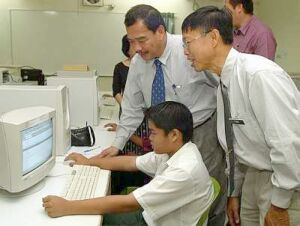
PRACTICAL SOLUTION: Tiong (right) and Kong observing Form Three student Loke Zhao Lin showing how the School Management System allows students to sit for a mock examination on Friday.
“All that is required is the password and one’s username. The system, however, has pre-defined parameters whereby an individual can only access information that is relevant to the person,” he told reporters here during a visit by Deputy Science, Technology and Innovation Minister Datuk Kong Cho Ha yesterday.
Tiong said the school was also using the system to track library loans, disciplinary records, and as a monitoring tool to record students’ punctuality and whereabouts.
“Each student has his own RFID tag. The student is required to scan it at readers within the school to keep track of his movement.
“The school and parents can confirm what time students arrive and leave, and their attendance at each classroom session,” said Tiong.
He said past and present students of the school had helped set up the system, including wiring up the school buildings with fibre optic cables.
“All equipment were either donated or bought second-hand,” he added.
Commending Tiong and the school for their efforts, Kong said having the School Management System had helped to boost the school’s reputation, and enrolment had risen from 320 students in 1992 to about 800 at present.
“The school’s popularity is growing so much so that parents are insisting on sending their children here,” said Kong, who is also Lumut MP.
He also urged Perridot Systems and the school to market the management system overseas.
“Software developed in our country are impressive but people have this mindset that they are only good if other countries have used them before.
“Therefore, the trick is to market them overseas first,” he added.
The Sun Daily – Headmaster turns rundown school into high-tech centre

Original Article – By Muhammad Husairy Othman
muhd@thesundaily.com
LUMUT, Sun: SMK Dindings principal Tiong Ting Ming is living proof of the adage the word “impossible” only exists in the dictionary of fools. The fact is this gentle-looking 49-year-old man has achieved a gargantuan feat. He single-handedly turned a dilapidated school into a high-tech learning institution.
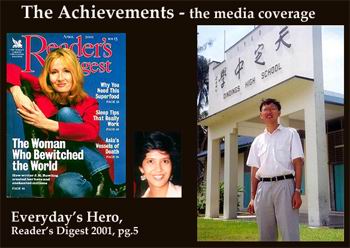
His achievement even caught the attention of the Readers Digest which featured him in an article entitled Everyday Heroes. During a recent interview with The Sun, the father of three was more than eager to share his thoughts and challenges in undertaking a task which was once look upon by the local community as impossible.
It all started in 1992 when he was promoted as principal of the school whose reputation rested more on its termite-infested wooden buildings, and with an enrolment of about 300 students. The condition of the school left Tiong in shock when he first set foot in it. Tiong decided to do something about it – he gritted his teeth and began to revamp the whole school turning it into a high-tech learning institution. From then on until August 1997, he practically begged and twisted the arms of many people into donating for his cause, netting more than RM1 million in cash and kind.
All this went into the renovation of the older blocks and the construction of a three-storey building which he lovingly refers to as cyber classrooms. “The whole building is interlinked via conduits for data cables.” In fact all the buildings in the school are interlinked via Local Area Network (LAN) while the fixing of the fibre optic cables were undertaken by Thomas & Betts, a US- based company, he said.
Having achieved this, he strived harder to get more donations to set up three computer laboratories in the new building and managed to raise another RM800,000 last year. He also envisioned setting up a school which provides state-of-the-art Information and Communication Technology (ICT) for students. He managed to sell this idea to several big corporations.
Among the major corporate sponsors who helped were Sapura IT which contributed 25 personal computers and the LAN system worth some RM150,000. Mimos provided the school with Internet connection worth RM60,000 while Thomas & Betts came in with fibre optic cables worth some RM100,000.
Hock Hua Bank Bhd donated 60 units of 486-100 NEC central processing units while 3Com Asia Pacific Ltd lends a helping hand with the technical aspects under the Netprep programme. NetPrep Curriculum & Equipment provides the school with the necessary teaching syllabus and course materials in a bid to ensure the whole programme is a success.
Despite having all these facilities, each student is only charged a nominal fee of RM10 per month while the Parents and Teachers Association (PTA) sponsors 50% of the RM10 for each poor student. Apart from being the only school in Perak with all these facilities, the school also makes it compulsory for all its form five students to take IT as one of the subjects in their Sijil Pelajaran Malaysia (SPM) examinations.
The pioneer group of students who sat for the examinations last year did exceptionally well with only four failures out of 104. Even the teachers in the school were not “spared” the innovations as Tiong has made it compulsory for them to attend at least 1 1/2 hours of computer classes every week.With the availability of such facilities coupled with Tiong’s commitment to the welfare of his charges, student enrolment jumped to an all time high of 879. “I plan to limit the number of students to 600 by next year to have a more conducive learning environment.” A strict disciplinarian, the bespectacled Tiong also had his fair share of encounters with stubborn and naughty students who broke the windscreen of his car and splashed paint on it.
“They did not take too kindly to me initially,” he smiled while pointing out that character building and mutual trust takes time to develop. Now he even lets the students have access to the computer laboratory after school hours,
and if they have certain projects to complete, they are allowed to use it in the evening in the main server room.
Another factor which makes the Sitiawan-born Tiong stand out from others is that he has no background in IT and yet he supervises and monitors the LAN system in the school. “I read a lot and this has enabled me to keep abreast with the latest changes in IT,” he said while pointing to a three-metre high bookshelf packed with numerous publications on the subject. “If I want my students to be self-learners, I must be one myself.” But no tall is over for the SMJK Dindings. Tiong still has the arduous task of making ends meet as the school needs about RM5,000 in donations, monthly. “This is my main problem. I am here before 7am and go home only after sunset.”
All Content Copyright © 2001 The Sun Media Corporation Sdn. Bhd. Produced by
SunCities.Net.

Original Article Published in ZDNet Asia, June 29, 2000
by Anita Devasahayam
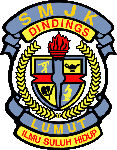 LUMUT, Malaysia: You may not find the Dindings High School, located in the hinterland of Malaysia’s northern state of Perak, on any map, and may pass it by without a second thought.
LUMUT, Malaysia: You may not find the Dindings High School, located in the hinterland of Malaysia’s northern state of Perak, on any map, and may pass it by without a second thought.
But located within its wooden walls and under zinc roofs are budding entrepreneurs of the new dot-com world.
The 800 students of the school, ranging in ages between 13 and 17, surf the Internet, learn Web design, digital art, networking, and programming in C, Visual Basic, Linux and Unix as part of their daily curriculum.
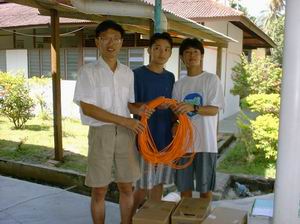
In their most recent school project, a group of 20 students received hands-on experience in laying a one-km 10Mbps fiber-optic cable to inter-link the school with a nearby primary school and kindergarten. The campus-wide high-band network was probably the first of its kind in the country that was commissioned and maintained by teenagers. The new link-up will enable students and teachers to experiment with classroom-to-classroom video-conferencing and other multimedia applications.
“By the time these students leave school, they will have enough technical know-how and skills to configure and use switches and hubs and manage networks,” said principal Tiong Ting Ming who is the driving force behind the rural school’s transformation.
Eight years ago, the radical 48-year-old principal, was assigned to the Dindings school located near the beachfront town of Lumut, where the community’s lives are mostly centered around trading, fishing and agriculture.
Tiong had come with the belief that the textbook-reliant, exam-oriented education system the school was governed by was not enough to equip his students to participate in a globalized economy. Added to that the less-motivated students were dropping out and he needed to stem the tide.
An Apple Macintosh fan, Tiong was switched on by the opportunities that computing technology could give his young charges. “One of the hardest things was convincing some of the more skeptical parents and technophobic teachers that computers are necessary to give the kids skills they could use in the real world,” he said.
When the Internet came along, it served to reinforce Tiong’s belief that he needed to arm his students for the future knowledge workplace. “The Internet is their future. I was convinced educating them to be responsible Net citizens and giving them the right skill sets had to start in school,” he said.
Persistence pays
A chemistry graduate, Tiong set about teaching himself to repair and upgrade old PCs and cajoled teachers and students to embrace the Internet. Only partially supported by government and without the cash-rich opportunities of urban schools, Tiong knocked on doors of corporations and benefactors to win them over.
“I visited one company in Kuala Lumpur seven times before they finally relented and gave me the first set of PCs and Macs to get us started,” said Tiong.
He also travelled personally on 800-km bus journeys to-and-fro Singapore to purchase spare parts to refurbish second-hand computers for his students. “Computer parts are expensive in Malaysia and are much cheaper from bargain hardware purveyors at Sim Lim Square in downtown Singapore,” he said.
With the aid of former-students, some generous individual donors, various companies, and the Ministry of Education, the school has since raised over 1.8 million ringgit (US$470,000), in cash and kind, to fund its efforts to build up a networked environment from scratch.
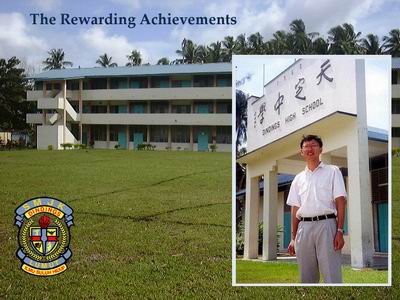
Wedged between a palm oil estate and a coconut plantation, the school now boasts a brand new three-storey block that is a hive of computing activity. Tiong’s office is more akin to a computer retail shop’s back-office, and is packed with an assortment of PCs, servers, peripherals, cables and an over-laden shelf filled with phonebook-sized technical manuals and books.
His open-door policy, during this interview, saw busy students come in armed with some component or another, then skitter off spouting geekspeak. Amid the clutter in the room there is even a bed to get some shut-eye and a fridge for snacks when his students are working on late-night “projects.”
One of those projects, administered by Tiong, was the wiring of the entire school including the classrooms, the library, the staff room, the administration office and computer labs.
The school now has over 100 PCs – 486s, Pentium 75s and Pentium MMX 166s – that give students and teachers instant access to the Internet via a 64Kbps leased line.
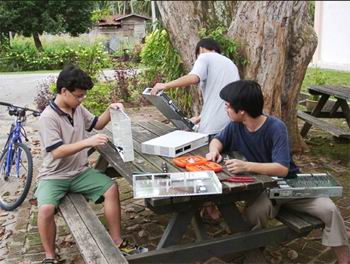
A cadre of trained students upkeep the PCs and administer the Dell 553MHz dual -processor main server, and a self-configured secondary and backup server.
The Red Hat Linux 6.1 powered-server houses their mail server, Apache Web server, proxy server, newsgroups, Internet Relay Chat, and file, print and backup server.
‘I chose Linux because the system cost me only 200 ringgit and was useful for my students to learn and configure,” he said.
Sowing the Net generation
Early last year, Tiong yanked biology as a subject from the curriculum for his Form Four (16-year-old) students and replaced it with information technology. “Better to know the innards of a computer than human or animal anatomy,” he thought.
He has since extended the subject school-wide, and all students have their own individual email and attend varied courses ranging from basic software to hardware troubleshooting and maintenance, programming, local area networking, and structured cabling and certification.
Students are also assigned projects by teachers to encourage them to do research on the Internet to complement their traditional subjects.
This year, a pioneer batch of 120 students will be taking Information Technology as an exam subject for the year-end compulsory government examinations, that is a prerequisite for university entrance.
Networking giant 3Com Corp adopted Dindings as the first of 11 schools in the country for its global NetPrep program to provide students with network management skills.
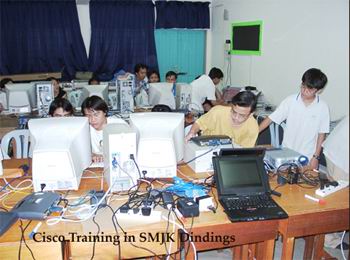
The first batch of 20 students are currently undergoing 160-hours of the intensive program and will be certified by the International Association of Communication Systems Engineers upon completion.
Tiong believes the hard work has begun to pay off. “I used to have to persuade parents to keep their children in school. Now I get queries from far and wide to have their children sent here,” he said. The student population has grown steadily, in tandem with the school’s computing firepower, from 320 to the present 800.
He discloses that school’s passing rate in year-end exams, a government barometer for a school’s success, is still only around 50 percent. “But their environment is sheltered. Introducing the Internet to the students has opened their minds tremendously and given them insights and the motivation to be discerning and analyze information,” he said.
Tiong said his ultimate goal is to provide an environment where the “Net culture” can thrive. He hopes students can be imprinted with a self – and life-long learning trait that they could retain beyond school walls.
He added that teachers in the country need to bone up to adapt to the rapidly shifting educational needs of students. “Teachers are at risk of becoming obsolete if they do not understand nor accept that they no longer hold a monopoly over the input their students receive. They must become as Net-savvy as their students. You can ignore the technology, but not the information,” he said.
Tiong is convinced the information technology skills his students acquire will equip them for life in the real working environment and to be more responsible with the use of the technology. It may even inspire some to become entrepreneurs. As Tiong puts it: “You can either be a paddy planter or rice eater. I am teaching my kids to be planters because that’s their future ricebowls.”

Published in ZDNet Asia
by Anita Devasahayam
CNet Asia – A fully-networked school rises in rural Malaysia

Original Article Published in CNET Asia, Nov 04, 1999
by Julian Matthews, Malaysian correspondent
LUMUT, Perak–If a school can be described as four walls with the future in it, then the Dindings National-Type Secondary School in rural Perak has confirmed its place in the new millennium.
Situated 95km from the nearest city Ipoh, the school is mostly made up of wooden buildings and wedged between a palm oil estate and a coconut plantation.
But running under the floors and in conduit piping along the corridors are Cat-5 networking cables inter-linking 70 PCs in the classrooms, the library, the staff room, the administration office, the science labs and computer labs. Every room has RJ-45 connectors that gives it instant access to the Internet on a 64Kbps leased line.
The school was wired almost entirely by its students who manage and administer the Redhat Linux 6.0 powered-server which houses their mail server, Apache web server, proxy server, newsgroups and Internet Relay Chat. “All my 690 students have their own email, can design homepages and do Linux, Unix and C programming,” said principal Tiong Ting Ming, 47. Students in the school range from 13 to 17 years of age.
Ironically, the school is not part of the 90 schools chosen as part of Malaysia’s Smart School Program which has been sharply criticized by the opposition for delays and faulty courseware.
Tiong spent seven years cajoling local corporations and benefactors to provide funding to transform the school into a network-ready environment for his students. Total investment currently amounts to RM1.8 million and major sponsors include Sapura Holdings, Mimos, Thomas & Betts and the Ministry of Education.
Tiong’s dedication earned the school its latest sponsor–networking giant 3Com Corp. 3Com Wednesday showcased the school as one of only two schools in Malaysia and 30 in Asia that are part of its global NetPrep program to provide students network management skills training.
3Com which organized the media tour donated RM32,000 worth of networking equipment and together with Universiti Tun Razak, will initially train a core group of 10 boys and four girls.
Students who complete the course will be certified by the International Association of Communication Systems Engineers.
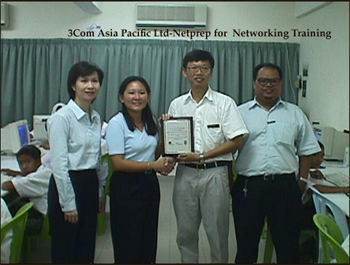
3Com Asia Pacific education and training manager Daphne Tham said: “We are preparing students of today for the workforce of the 21st century.” About 200 schools and tertiary institutions worldwide have joined the NetPrep program.
Tham said 3Com was wary of the program being positioned merely for elite schools and Dindings was a prime example of its reach even in rural areas.
Principal Tiong said his mission is not just to impart knowledge from textbooks but to create a “Net culture” where students will be attuned to self- and life-long learning and retain this trait beyond school walls. “The Internet is their future, educating them to be responsible Net citizens has to start now,” he said.
This year, the radical principal yanked biology as a subject from the curriculum and replaced it with information technology. Next year, IT will be offered as an exam subject for the first time for the year-end compulsory government examinations.
“Next month, my students will also install and commission a fibre-optic backbone from the school to the primary school and kindergarten next door,” said Tiong who plans to raise the student-to-computer ratio from the present 12:1 to 5:1 and add a 128Kbps ISDN Internet link-up soon.
Student Ho Guan Hwang said: “When my principal told us four years ago he was going to wire the school, I had my doubts. Today I know about the Net and can learn how to install fiber cables and have networking and programming skills. All this is so expensive to learn. We are very lucky we can do this in school.”
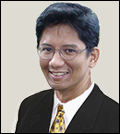
Note: Published in CNET Asia, Nov 04, 1999
by Julian Matthews, Malaysian correspondent